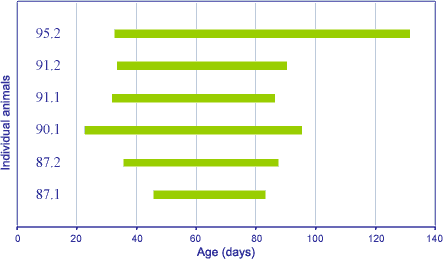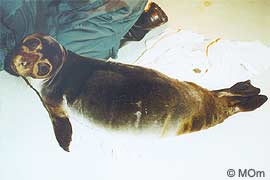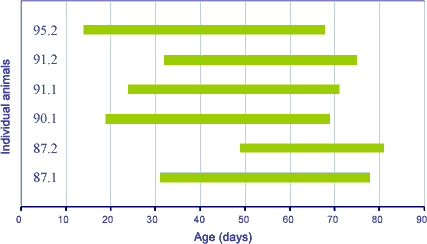Introduction
As part of an action plan for the conservation of the critically endangered Mediterranean monk seal Monachus monachus, a rehabilitation programme has been established in Greece since 1990, aiming at increasing the survival possibilities of animals needing aid and releasing them healthy into their natural environment. A standard practice during the rehabilitation period is the recording of various development parameters in order to:
- Contribute to the diagnosis of the condition of the animal and the evaluation of the progress of treatment.
- Create a database, that may be used for the further improvement of the rehabilitation programme, but also in cases of emergency (epidemics, catastrophes, breeding in captivity).
- Acquire data on the species difficult to collect from animals in the wild.
Here we present data on the growth, relative to the diet, and development of six Mediterranean monk seal pups rehabilitated in the Centre. All pups, four males and two females, were admitted at the age of 1 - 3 weeks old. Upon admission in the facilities, they were all orphans and exhibited symptoms of dehydration, starvation and in one case multiple infections. The rehabilitation lasted between 3-6 months, depending on their health status, growth and their capability to survive in the wild.
Methodology
Age determination
The age of the animals is estimated upon admission, (with an accuracy of ± 5 days) based on the following characteristics: the presence/absence of the umbilical cord or fresh umbilicus, the dental eruption and the state of the moulting process, as described in relevant studies for the species in the wild.
Growth:
 Daily measurement of food intake/ feeding methodology: Feeding and caloric input influence development parameters. All meals are weighed with an accuracy of 10 gr. In liquid meals, water and fish are weighed separately. The feeding program of the pups starts with rehydration therapy and within 24-48 hours after admission the animal starts to take its first food: fish porridge, which is later replaced by whole fish . During the development of the animal the feeding program is adjusted in order for the animal to learn hunting and feeding by itself . The feeding methodology progresses from tube feeding of liquid food, to force feeding of solid fish, to hand feeding and last stage the self-feeding in the pool. Daily measurement of food intake/ feeding methodology: Feeding and caloric input influence development parameters. All meals are weighed with an accuracy of 10 gr. In liquid meals, water and fish are weighed separately. The feeding program of the pups starts with rehydration therapy and within 24-48 hours after admission the animal starts to take its first food: fish porridge, which is later replaced by whole fish . During the development of the animal the feeding program is adjusted in order for the animal to learn hunting and feeding by itself . The feeding methodology progresses from tube feeding of liquid food, to force feeding of solid fish, to hand feeding and last stage the self-feeding in the pool.
 Measurement of body weight: Upon admission, and approximately once in two days thereafter the animals are weighed at set time on a scale of 0,5 kg accuracy. When the animals exceed the weight of 25 kg, they are weighed twice a week. After 35 kg., the animals are stressed during this procedure and thus measurements are conducted only once a week. Measurement of body weight: Upon admission, and approximately once in two days thereafter the animals are weighed at set time on a scale of 0,5 kg accuracy. When the animals exceed the weight of 25 kg, they are weighed twice a week. After 35 kg., the animals are stressed during this procedure and thus measurements are conducted only once a week.
Moulting: From the first day of appearance of moulting, a daily record with detail description of the moulting pattern and extend is kept, including photographs of the animal.
Dentition: Dentition is checked daily and the pattern of its development is recorded, until the animal is in full dentition (32 teeth with dental formula: incisors 2/2, canines 1/1 and post canine elements 5/5.
Results
The growth of the animals is closely related to their food intake and method, as well as on their overall health status. The weight of the seal 95.2 (Katerina), while it was tube fed, mainly on fish porridge, and force fed on solid fish remained stable at the level of about 13 kg, where it was found, although the feeding quantity was gradually increased. When it started to be hand fed, its weight increased in parallel with the increase in food quantity. On day 91, the seal exhibited gastrointestinal problems and it was put on a diet. During this period, the animal's weight decreased, but being hungry the animal started to eat on its own from the fish thrown in the pool, in order to develop its ability to hunt. From this point onward the food quantity provided was rather stabilised, while the seal was left to eat the amount it needed. It gained weight gradually until it reached 53 kg on the day of its release.
Growth curve of seal 95.2 (Katerina)

Weight curve of pups

The weight of the pups on admission ranged from 12.8 - 20 kg and increased gradually to reach 50 - 70 kg., at release. The animals at the same age have similar weight, with the exception of 91.1. (Stelios), which exhibited a vey fast improvement and in three months period it was released The rest of the animals were released after an average of 6 months treatment.
Development of moulting
The duration of moulting of the pup lanugo was found to be quite variable and it was observed to last from 35-96 days, starting at the age of 4-5 weeks old. This variability may be related to the health status and the growth of the animals, something also observed in the Hawaiian monk seal. Animals with consistent health problems such as 90.1 (Theodore) and 95.2 (Katerina) , being occasionally on a diet, exhibited prolonged moulting. In general, the moulting period in the rehabilitation facilities is protracted, in comparison with the pups in the wild, where it may start at about the same age but it seems to be completed in 2-3 weeks' time based on the studies of the population of the N.Sporades. However, it has to be noted, that in the rehabilitation setting moulting is recorded in detail from its first till its last day. It is possible that the last period, while the animals are almost completely moulted (with the exception of limited areas on the face and flippers), cannot be distinguished in the wild, unless the animals are disturbed.

|










